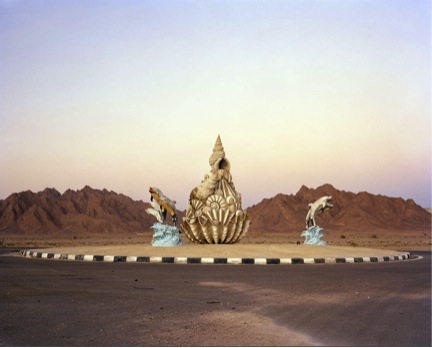Photographer Julien Chatelin’s images capture Egypt’s surreal and absurd rural landscape; a road that leads to nowhere.
The images of a crowded and riotous Tahrir Square are the most recent portraits of Egypt burnished in the public imagination. They offer a glimpse into a constantly evolving narrative of a nation whose political upheaval has transformed our understanding and perceptions of politics in the Arab world.
Far from Cairo’s tumultuous center, however, lies a world trapped in time, cities littered with the remains of real-estate promoters’ pharaonic projects. It is an abandoned landscape where a solitary figure wandering the empty streets seems to endlessly linger, and the half-built apartment buildings scattered on the sides of the road give the impression not only of defeat, but a cruel absurdity.
A lonely door built in the middle of the desert, a forest of lampposts, a mosque shaped like a spaceship; emptiness turns brutally into strangeness, creating a tension between people and their environment. This is Egyptorama—a road trip that leads nowhere.
A lonely door built in the middle of the desert, a forest of lampposts, a mosque shaped like a spaceship; emptiness turns brutally into strangeness, creating a tension between people and their environment. This is Egyptorama—a road trip that leads nowhere.
The photographs in this series were taken in Egypt in the midst of the enduring turmoil sparked by the revolution, but they do not belong to a particular moment in time, much less to any one city. They are photographs from a lost and hidden corner of Egypt, spread across more than 8,000 kilometers, and yet they are not exclusive to it. They are portraits not of a country or movement, but of isolation, emptiness and the futile and sometimes absurd lengths that we as individuals and nations are willing, or are forced to go in order to fill those voids. This is an Egypt without narrative; an Egypt that is an aperture into a desolate and haunting beauty that endures.

